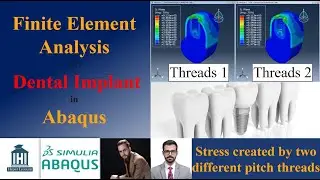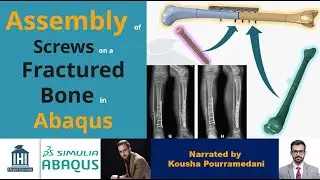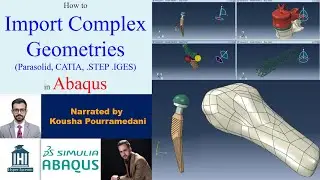Finite Element Analysis of Dental Implant in Abaqus
In this simulation, we consider different thread profiles for the Abaqus model. The merge/cut option was used to assemble the parts. In order to achieve accurate results, we define the friction contact interaction between the implant and the bone. We apply the load as amplitude to mimic the chewing process. In the results section, we will compare the stress between the bone and implant. The general contact algorithm with contact property is beneficial in this simulation and we use it for all contact surfaces between the parts. We assign the customary boundary condition to the mandible and concentrated force with smooth amplitude for the superstructure. The mesh should be fair because of the complexity of the model.
Modelling process:
We start the simulation by modelling the superstructure (crown), abutment, and mandible bones in three-dimensional parts. Then, we assemble the simulated components and divide the bone into cortical and spongy parts. Since the process is static we use a static general step and consider titanium alloy as the material for the implant. Next, we choose the bone’s mechanical properties for cortical and spongy parts separately. We use the ceramic material with elastic behavior for the superstructure component. This is due to the fact that the superstructure never experiences the plastic region and if it excises yield stress it is considered as part failure. The jawbone is also modelled as an elastic material because of the same reason.
-----------------------------------------------------------------------------------------------
Incrementation in Abaqus:
https://hyperlyceum.com/product/incre...
Master and Slave contact:
https://hyperlyceum.com/product/too-m...
Assembly in Abaqus:
https://hyperlyceum.com/product/abaqu...
Importing complex parts:
https://hyperlyceum.com/product/impor...
-----------------------------------------------------------------------------------------------
This simulation could be constructive in many fields, especially the biomechanics industry and companies in the mentioned area. It could give you some insights for modelling biomechanics simulations and implant design.
This video is about 20 minutes long and helps you to learn how to use Abaqus to simulate dental implants. In this product, you can find the following files:
Abaqus files: CAE, INP, and JNL
Here is the link for the video:
https://hyperlyceum.com/product/finit...
and you can visit our website here:
https://hyperlyceum.com
This video is provided by Saman Hosseini. For more information, please send him an Email:
[email protected]
-----------------------------------------------------------------------------------------------
The table of content of this video is as follows:
0:00 Introduction
0:13 Creating the parts
5:05 Material property
6:29 Assembly
7:30 Creating step
8:08 Defining Interactions
9:20 Load and BCs
10:02 Meshing
11:18 Creating the second model
12:49 Evaluating the results
14:16 Ending
-----------------------------------------------------------------------------------------------
Here is some additional information:
Abaqus in Biomechanics:
The Finite Element Method (FEM) is a numerical method for solving various engineering problems. Abaqus software is one of the most powerful finite element software to solve various problems with complex geometries and components. The software provides a great environment to study various models. Not even solid mechanics but also thermal and fluid mechanic models can be simulated in this software. It is worth to mention the fluid mechanic model was separated after Abaqus 6.16 and since version 2017 the company start to develop an independent solver for it.
Extensive use of the dental implant in Abaqus and biomechanics shows the importance of using simulation in this field. These studies require the model of the anatomy as it is in reality. This leads engineers and researchers in mechanical and biomedical engineering to study each component in more detail. These studies are significantly important for manufacturing implants.
Implants:
The implants fuse to the jawbone and provide stable support for the artificial teeth. Dentures and bridges mounted to implants will not slip or shift in the mouth which is a significant benefit for eating and speaking. This secure fit helps the dentures and bridges and individual crowns placed over implants feel more natural than conventional bridges or dentures.



















